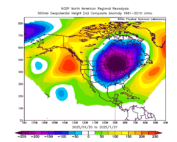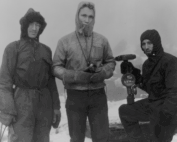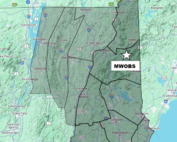Solstices and Equinox
2011-06-23 16:21:18.000 – Ryan Knapp, Meteorological Observer
Mount Washington, home of the three setting suns
During my first summer up here, my coworker at the time, Jim Salge, wrote an observer comment (see Thursday, June 22, 2006) about our crew’s observation of the sunset during the first day of summer. In the comment, he wrote about how the sun was setting at its northern most point, just south of Jay Peak in Vermont near the Canadian border. Or in closer terms, it sets almost in line with Cherry Pond to the northwest. In contrast, during the winter solstice, the sun sets behind Killington, Vermont. Or in closer terms, it sets just south of Mount Lafayette to our southwest. So from our vantage, the suns setting point in the summer versus that of winter is a difference of 66 degrees on the compass. In words, this sounds interesting but it is even more impressive to look out on a clear day and visualize this difference. But unless our horizon is seared into your memory, this visualization might be a bit difficult to imagine. So from that point forward, I set out to create a single image that would show this difference. Sounds easy enough but it actually proved just the opposite and took me five years to get the image I originally set out to do.
So, why did it take five years and not six months? First is our shift scheduling. Working every other week, this meant that I might be up here for the summer solstice but not the winter solstice. But this wasn’t the biggest issue. The biggest issue was (and this may not be surprising) the weather. Since the summit spends over 60 percent of the year in the fog, the odds of having a clear day on or around the solstices’ were not in my favor. Or if we were fog free, there might be clouds with bases below the summit limiting our views or clouds above the summit and horizon making the sun set behind a gray curtain. Or there was so much haze around the summit that distant or neighboring peaks were difficult to distinguish. So, there was a lot of limiting weather factors that worked into my creation. But, I finally got what I set out to do this past winter.
Knowing I had the images I needed, I just needed to find the time and motivation to put my image together. I found this time and motivation this past off week during one rainy afternoon. I sorted through my 5000+ images on my home server and found four useable images, one for the winter solstice, one for the spring equinox, one for the summer solstice, and one for the fall equinox. Then after four hours of layering, stitching, cloning, color correcting, aligning, and other editing techniques, I got my desired image (click on the thumbnail with this comment to make it larger). And while the most difficult part was cloning out the radio antenna (due to sizing issues), I think this image shows the four seasons pretty well. And if it’s a bit confusing and reminiscent of a planet from Star Wars or something, what you are looking at is a picture with the winter solstice in the left of the picture, spring/fall equinox in the middle of the picture, and the summer solstice in the right of the picture. Now, I just need to get one like it for the differences in sunrises…
Ryan Knapp, Meteorological Observer
Going with the Flow: Why New England Didn’t Experience Any Classic Nor’easters This Winter
Going with the Flow: Why New England Didn’t Experience Any Classic Nor’easters This Winter By Peter Edwards Why didn’t the Northeast experience any major snowstorms this year? If I had to guess, it’s the
A Look at The Big Wind and Measuring Extreme Winds At Mount Washington
A Look at The Big Wind and Measuring Extreme Winds at Mount Washington By Alexis George Ninety-one years ago on April 12th, Mount Washington Observatory recorded a world-record wind speed of 231 mph. While
MWOBS Weather Forecasts Expand Beyond the Higher Summits
MWOBS Weather Forecasts Expand Beyond the Higher Summits By Alex Branton One of the most utilized products provided by Mount Washington Observatory is the Higher Summits Forecast. This 48-hour forecast is written by MWOBS






